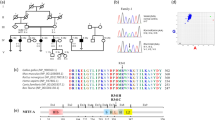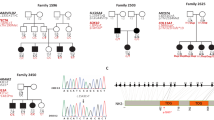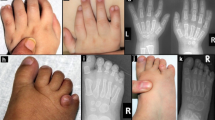Abstract
Waardenburg syndrome (WS) is a combination of deafness and pigmentary disturbances, normally inherited as an autosomal dominant trait. The pathology involves neural crest derivatives, but WS is heterogeneous clinically and genetically. Some type I WS families show linkage with markers on distal 2q and in three cases the disease has been attributed to mutations in the PAX3 gene. PAX3 encodes a paired domain, a highly conserved octapeptide and probably also a paired–type homeodomain. Here we describe a further three PAX3 mutations which cause WS; one alters the octapeptide motif plus the presumed homeodomain; a second alters all three elements and the third alters the paired box alone. The latter occurs in a family with probable type 2 WS, a clinical variant usually considered not to be allelic with type 1 WS.
This is a preview of subscription content, access via your institution
Access options
Subscribe to this journal
Receive 12 print issues and online access
$209.00 per year
only $17.42 per issue
Buy this article
- Purchase on Springer Link
- Instant access to full article PDF
Prices may be subject to local taxes which are calculated during checkout
Similar content being viewed by others
References
Gruss, P. & Walther, C. Pax in Development. Cell 69, 719–722 (1992).
Jordan, T. et al. The human PAX6 gene is mutated in two patients with aniridia. Nature Genet. 1, 328–332 (1992).
Glases, T., Walton, D.S. & Maas, R.L. Genomic structure, evolutionary conservation and aniridia mutations in the human PAX6 gene. Nature Genet. 2, 232–339 (1992).
Tassabehji, M. et al. Waardenburg syndrome patients have mutations in the human homologue of the Pax-3 paired box gene. Nature 355, 635–636 (1992).
Baldwin, C.T. et al. An exonic mutation in the HuP2 paired domain gene causes Waardenburg's syndrome. Nature 355, 637–638 (1992).
Morell, R., Friedman, T.B., Moeljopawiro, S., Hartono, Soewito & Asher, J.H. A frameshift mutation in the HuP2 paired domain of the probable human homolog of murine Pax-3 is responsible for Waardenburg syndrome type 1 in an Indonesian family. Hum. molec. Genet. 1, 243–247 (1992).
Mendelian Inheritance in Man 9th edn (ed. McKusick, V. A.) (Johns Hopkins University Press, Baltimore, 1991).
Foy, C., Newton, V.E., Wellesley, D., Harris, R. & Read, A.P. Assignment of WS1 locus to human 2q37 and possible homology between Waardenburg syndrome and the Splotch mouse. Am. J. hum. Genet. 46, 1017–1023 (1990).
Goulding, M.D., Chalepakis, G., Deutsch, U., Erselius, J.R. & Gruss, P. Pax-3, a novel murine DNA-binding protein expressed during early neurogenesis. EMBO J. 10, 1135–1147 (1991).
Epstein, D.J., Vekemans, M. & Gros, P. Splotch (Sp2H), a mutation affecting development of the mouse neural tube, shows a deletion within the paired homeodomain of Pax-3. Cell 67, 767–774 (1991).
Burri, M., Tromvoukis, Y., Bopp, D., Frigerio, G. & Noll, M. Conservation of the paired domain in metazoans and its structure in three isolated human genes. EMBO J. 8, 1183–1190 (1989).
Newton, C.R., Graham, A. & Heptinstall, L.E. Analysis of any point mutation in DNA: the amplification refractory mutation system. Nucl. Acids Res. 17, 2503–2516 (1989).
Newton, V.E. Waardenburg's syndrome: a comparison of biometric indices used to diagnose lateral displacement of the inner canthi. Scand. Audiol. 18, 221–223 (1989).
Farrer, L.A. et al. Waardenburg syndrome (WS) type 1 is caused by defects at multiple loci, one of which is near ALPP on chromosome 2: first report of the WS Consortium. Am. J. hum. Genet. 50, 902–913 (1992).
Chalepakis, G. et al. The molecular basis of the undulated/Pax-1 mutation. Cell 66, 873–884 (1991).
Walther, C. et al. Pax: a murine multigene family of paired box-containing genes. Genomics 11, 424–434 (1991).
Wilcox, E.R., Rivolta, M.N., Ploplis, B., Potterf, S.B. & Fex, J. The HuP2 gene is mapped to chromosome 2, together with a highly informative CA dinucleotide repeat. Hum. molec. Genet. 1, 215 (1992).
Moase, C.E. & Trasler, D.G. Splotch locus mouse mutants: models for neural tube defects and Waardenburg syndrome type 1 in humans. J. med. Genet. 29, 145–151 (1992).
Balling, R., Deutsch, U. & Gruss, P. Undulated, a mutation affecting the development of the mouse skeleton, has a point mutation in the paired box of Pax-1. Cell 55, 531–535 (1988).
Hill, R.E. et al. Mouse Small eye results from mutations in a paired-like homeobox-containing gene. Nature 354, 522–525 (1991).
Ton, C.C.T. et al. Positional cloning and characterization of a paired box- and homeobox-containing gene from the aniridia region. Cell 67, 1059–1074 (1991).
Author information
Authors and Affiliations
Rights and permissions
About this article
Cite this article
Tassabehji, M., Read, A., Newton, V. et al. Mutations in the PAX3 gene causing Waardenburg syndrome type 1 and type 2. Nat Genet 3, 26–30 (1993). https://doi.org/10.1038/ng0193-26
Received:
Accepted:
Issue Date:
DOI: https://doi.org/10.1038/ng0193-26
This article is cited by
-
Maternal transmission effects of the PAX genes among cleft case–parent trios from four populations
European Journal of Human Genetics (2009)
-
Transcriptional and signaling regulation in neural crest stem cell-derived melanocyte development: do all roads lead to Mitf?
Cell Research (2008)
-
Linkage to chromosome 2q36.1 in autosomal dominant Dandy-Walker malformation with occipital cephalocele and evidence for genetic heterogeneity
Human Genetics (2008)
-
Current perspectives on the genetic causes of neural tube defects
Neurogenetics (2006)



